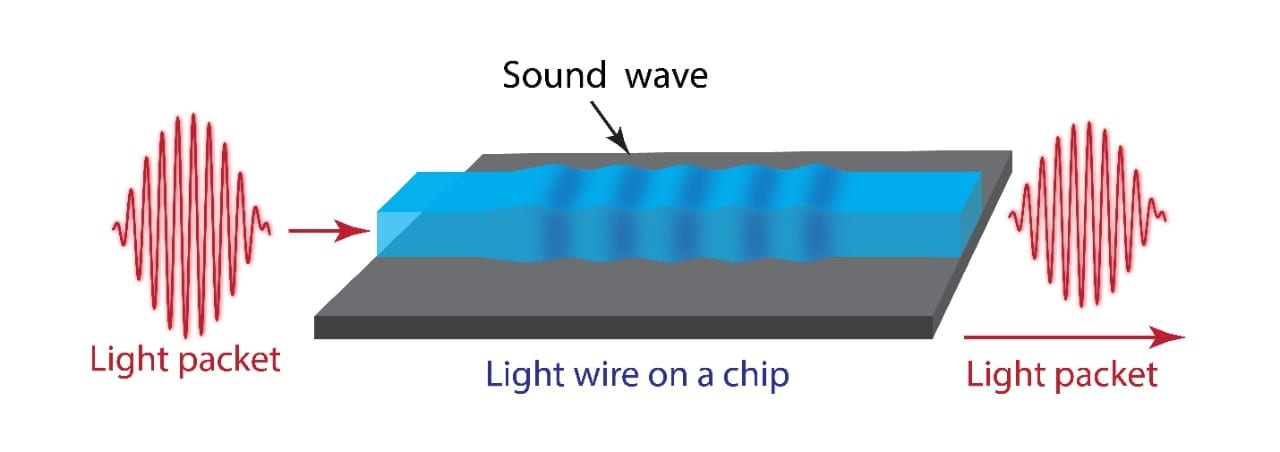
Engineers have successfully married electrons and photons within a single-chip microprocessor, a landmark development that opens the door to ultrafast, low-power data crunching.
The researchers packed two processor cores with more than 70 million transistors and 850 photonic components onto a 3-by-6-millimeter chip. They fabricated the microprocessor in a foundry that mass-produces high-performance computer chips, proving that their design can be easily and quickly scaled up for commercial production.
The new chip, described in a paper to be published Dec. 24 in the print issue of the journal Nature, marks the next step in the evolution of fiber optic communication technology by integrating into a microprocessor the photonic interconnects, or inputs and outputs (I/O), needed to talk to other chips.
“This is a milestone. It’s the first processor that can use light to communicate with the external world,” said Vladimir Stojanovi, an associate professor of electrical engineering and computer sciences at the University of California, Berkeley, who led the development of the chip. “No other processor has the photonic I/O in the chip.”
Stojanovi and fellow UC Berkeley professor Krste Asanovi teamed up with Rajeev Ram at the Massachusetts Institute of Technology and Miloš Popovi at the University of Colorado Boulder to develop the new microprocessor.
“This is the first time we’ve put a system together at such scale, and have it actually do something useful, like run a program,” said Asanovi, who helped develop the free and open architecture called RISC-V (reduced instruction set computer), used by the processor.
Greater bandwidth with less power
Compared with electrical wires, fiber optics support greater bandwidth, carrying more data at higher speeds over greater distances with less energy. While advances in optical communication technology have dramatically improved data transfers between computers, bringing photonics into the computer chips themselves had been difficult.
That’s because no one until now had figured out how to integrate photonic devices into the same complex and expensive fabrication processes used to produce computer chips without changing the process itself. Doing so is key since it does not further increase the cost of the manufacturing or risk failure of the fabricated transistors.
The researchers verified the functionality of the chip with the photonic interconnects by using it to run various computer programs, requiring it to send and receive instructions and data to and from memory. They showed that the chip had a bandwidth density of 300 gigabits per second per square millimeter, about 10 to 50 times greater than packaged electrical-only microprocessors currently on the market.
The photonic I/O on the chip is also energy-efficient, using only 1.3 picojoules per bit, equivalent to consuming 1.3 watts of power to transmit a terabit of data per second. In the experiments, the data was sent to a receiver 10 meters away and back.
“The advantage with optical is that with the same amount of power, you can go a few centimeters, a few meters or a few kilometers,” said study co-lead author Chen Sun, a recent UC Berkeley Ph.D. graduate from Stojanovi’s lab at the Berkeley Wireless Research Center. “For high-speed electrical links, 1 meter is about the limit before you need repeaters to regenerate the electrical signal, and that quickly increases the amount of power needed. For an electrical signal to travel 1 kilometer, you’d need thousands of picojoules for each bit.”
The achievement opens the door to a new era of bandwidth-hungry applications. One near-term application for this technology is to make data centers more green. According to the Natural Resources Defense Council, data centers consumed about 91 billion kilowatt-hours of electricity in 2013, about 2 percent of the total electricity consumed in the United States, and the appetite for power is growing exponentially.
This research has already spun off two startups this year with applications in data centers in mind. SiFive is commercializing the RISC-V processors, while Ayar Labs is focusing on photonic interconnects. Earlier this year, Ayar Labs – under its previous company name of OptiBit – was awarded the MIT Clean Energy Prize. Ayar Labs is getting further traction through the CITRIS Foundry startup incubator at UC Berkeley.
The advance is timely, coming as world leaders emerge from the COP21 United Nations climate talks with new pledges to limit global warming.
Further down the road, this research could be used in applications such as LIDAR, the light radar technology used to guide self-driving vehicles and the eyes of a robot; brain ultrasound imaging; and new environmental biosensors.
‘Fiat lux’ on a chip
The researchers came up with a number of key innovations to harness the power of light within the chip.
Read more: Engineers demo first processor that uses light for ultrafast communications
The Latest on: Photonic-electronic microprocessors
[google_news title=”” keyword=”photonic-electronic microprocessors” num_posts=”10″ blurb_length=”0″ show_thumb=”left”]
via Google News
The Latest on: Photonic-electronic microprocessors
- SPIE DCS 24 addresses photonics and sustainable chip manufacturingon April 30, 2024 at 5:00 pm
innovation in photonic chips and/or the coupling of photonic and electronic chips offers great promise. “Can we get away from copper interconnects?” she asked. “Photonic interconnects—they’re not new ...
- ECTC 2024 to highlight emerging technologies enabling heterogeneous integration and photonicson April 30, 2024 at 10:55 am
The IEEE Electronic Components and Technology Conference (ECTC) is the world’s leading forum for unveiling, discussing, and exhibiting the latest advancements in microelectronics packaging and ...
- Automotive Electronicson April 23, 2024 at 5:00 pm
Recom has created a chassis-mount isolated dc-dc converter for nominal battery voltages from 24 to 90V. Called RMOD360-UW, it can deliver full power continuously with inputs between 27 and 106V, as ...
- Study shines light on properties and promise of hexagonal boron nitride, used in electronic and photonics technologieson April 23, 2024 at 2:00 am
Single-photon emitters (SPEs) are akin to microscopic lightbulbs that emit only one photon (a quantum of light) at a time. These tiny structures hold immense importance for the development of quantum ...
- Introducing Photonicson April 18, 2024 at 8:53 pm
In the final chapters, a sweeping panorama of current and future applications and innovations inspires the reader with the excitement and promise of the burgeoning field covered by this book: ...
- RF General-Purpose Photonic Processoron April 16, 2024 at 5:01 pm
“A general-purpose photonic processor can be built integrating a silicon photonic programmable core in a technology stack comprising an electronic monitoring and controlling layer and a software layer ...
- HKIAS Distinguished Lecture Series on Electronics and Photonicson March 8, 2024 at 4:00 pm
Electronics and photonic technologies advanced rapidly in the last two decades and have become promising solutions to complement electronic technologies. To showcase the top-notch research and develop ...
- A roadmap for nanophotonicson February 20, 2024 at 7:07 am
Electronic–photonic integration at the chip level ... but will require a fresh approach to design and production. Microprocessors will require very large bandwidth communications on-chip as ...
- Wiring electronics with lighton February 19, 2024 at 7:56 am
The realization of this has increased not only the computing power of microprocessors ... Although integrated silicon photonic devices promise both low cost and high-volume manufacturability ...
- Ambient Photonics to Demo Light Powered Electronics at CESon January 7, 2024 at 5:22 pm
Ambient Photonics, a company that has been developing low-light solar cell technology for use in a variety of electronic devices, is set to present its products at the Consumer Electronics Show ...
via Bing News










